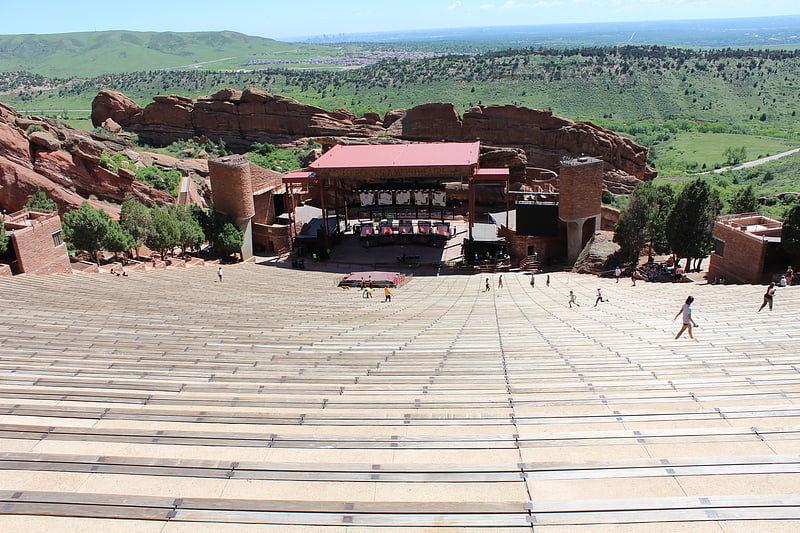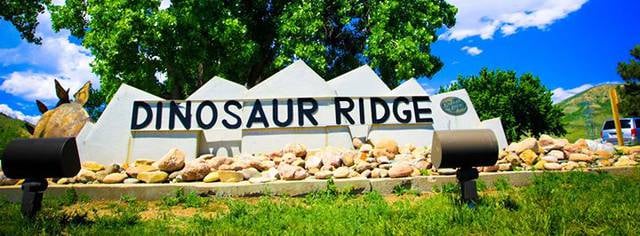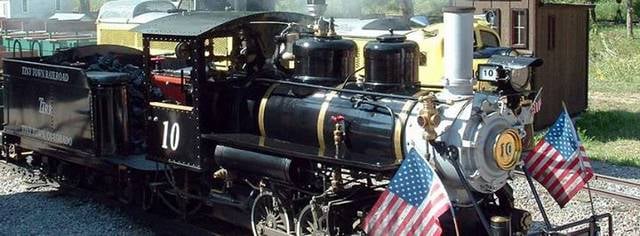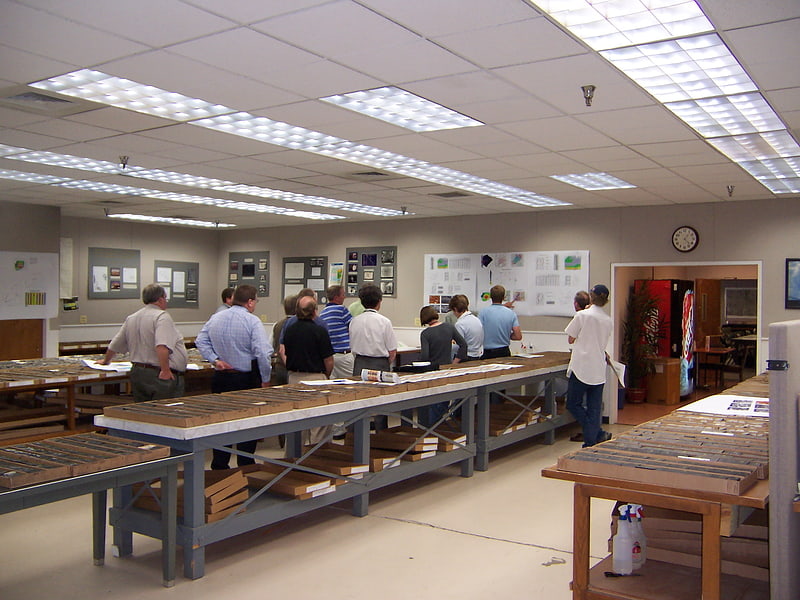Discover 6 hidden attractions, cool sights, and unusual things to do in Morrison (United States). Don't miss out on these must-see attractions: Morrison Natural History Museum, Red Rocks Amphitheatre, and Dinosaur Ridge. Also, be sure to include Tiny Town in your itinerary.
Below, you can find the list of the most amazing places you should visit in Morrison (Colorado).
Table of Contents
Morrison Natural History Museum

Museum in Morrison, Colorado. The Morrison Natural History Museum is a natural history museum located in Morrison, Colorado. The exhibits include several dinosaur fossils that were found nearby. Hands-on exhibits are designed to appeal to both children and adults, scientists and non-scientists.[1]
Address: 501 Highway 8, 80465-3001 Morrison
Red Rocks Amphitheatre

Reserve with red cliffs and amphitheater. Red Rocks Amphitheatre is an open-air amphitheatre built into a rock structure in the western United States, near Morrison, Colorado, ten miles west of Denver. There is a large, tilted, disc-shaped rock behind the stage, a huge vertical rock angled outwards from stage right, several large outcrops angled outwards from stage left and a seating area for up to 9,525.
In 1927, the City of Denver purchased the area of Red Rocks; construction of the amphitheater began in 1936, and was opened to the public in June 1941. Since then, many notable performances and recordings for film and television have taken place there. In June 2015, the Colorado Music Hall of Fame opened in the Trading Post at Red Rocks.
The elevation of the amphitheatre's top row is approximately 6,450 feet (1,965 m) above sea level, and the surrounding Red Rocks Park covers 868 acres (1.4 sq mi; 3.5 km2). The amphitheater is owned and operated by the City and County of Denver and is located in Red Rocks Park, part of the Denver Mountain Parks. The audience faces east-northeast, toward southern Denver, with the skyline of downtown visible to the left.
In 1957, the American Institute of Architects selected Red Rocks to be Colorado's entry at the National Gallery of Art for the AIA's Centennial Exhibition.
In 1999, after Pollstar magazine awarded Red Rocks the annual honor of best small outdoor venue for the eleventh time, the magazine changed the name of the award to the Red Rocks Award and removed Red Rocks from the running.
Construction began in October 2020 to replace the existing stage roof and structure.[2]
Address: 18300 W Alameda Pkwy, 80465-8737 Morrison
Dinosaur Ridge

Dinosaur Ridge is a segment of the Dakota Hogback in the Morrison Fossil Area National Natural Landmark located in Jefferson County, Colorado, near the town of Morrison and just west of Denver.
The Dinosaur Ridge area is one of the world's most famous dinosaur fossil localities. In 1877, fossil excavation began at Dinosaur Ridge under the direction of paleontologist Othniel Charles Marsh. Some of the best-known dinosaurs were found here, including Stegosaurus, Apatosaurus, Diplodocus, and Allosaurus. In 1973, the area was recognized for its uniqueness as well as its historical and scientific significance when it was designated the Morrison Fossil Area National Natural Landmark by the National Park Service. In 1989, the Friends of Dinosaur Ridge formed to address increasing concerns regarding the preservation of the site and to offer educational programs on the area's resources.
The rocks on the west side of Dinosaur Ridge are part of the widespread Morrison Formation of Jurassic age. It is in these rocks, where Arthur Lakes discovered the dinosaur bones in 1877. Fifteen quarries were opened along the Dakota hogback in the Morrison area in search of these fossils.
The rocks on the east side of Dinosaur Ridge are part of the Cretaceous Dakota Formation. When Alameda Parkway was being constructed in 1937 to provide access to Red Rocks Park, workers discovered hundreds of dinosaur footprints. These were found to include mostly Iguanodon-like footprints, perhaps from Eolambia. Carnivorous theropod tracks are also present.
The site features the Dinosaur Ridge Exhibit Hall with displays about the dinosaurs found at the site. Additionally, Dinosaur Ridge has interpretive signs at trail locations that explain the local geology, a volcanic ash bed, trace fossils, paleo-ecology, economic development of coal, oil and clay, and many other geologic and paleontological features.
In June 2011, Dinosaur Ridge was combined with another track site, the Parfet Prehistoric Preserve, about three miles north. The combined National Natural Landmark is now the Morrisson-Golden Fossil Areas.[3]
Address: 16831 W Alameda Pkwy, 80465-9703 Morrison
Tiny Town

Village in Colorado. Tiny Town & Railroad is a miniature village containing over 100 1/6 scale buildings and a 15 in gauge miniature railway close to Morrison, Colorado.[4]
Address: 6249 S Turkey Creek Rd, 80465-9502 Morrison
Red Rocks Park

Park in Jefferson County, Colorado. Red Rocks Park is a mountain park in Jefferson County, Colorado, owned and maintained by the city of Denver as part of the Denver Mountain Parks system. The park is known for its very large red sandstone outcrops. Many of these rock formations within the park have names, from the mushroom-shaped Seat of Pluto to the inclined Cave of the Seven Ladders. The most visited rocks, around Red Rocks Amphitheatre, are Creation Rock to the north, Ship Rock to the south, and Stage Rock to the east.
The red sandstone found throughout Red Rocks Park is geologically identified as belonging to the Fountain Formation. Other Colorado examples of Fountain Formation geology include nearby Roxborough State Park, Garden of the Gods near Colorado Springs, and the Flatirons near Boulder. The rocks were formed about 290-296 million years ago when the Ancestral Rocky Mountains were eroded during the Pennsylvanian epoch. Later, uplift during the Laramide orogeny tilted the rocks to the angle at which they sit today.
An Army expedition led by Stephen Long discovered present-day Red Rocks in 1820. The park was in times far past a favored campsite of the Ute tribe for it provided natural cover from the elements. Its earliest known name was the Garden of the Angels, reputedly given to it on July 4, 1870, by Martin Van Buren Luther, a pioneer Colorado judge. In 1872 Marion Burts became the first recorded owner of Red Rocks. He sold it to Leonard H. Eicholtz, a civil engineer who helped build the Union Pacific Railway and who developed the property into a park in 1878. Eicholtz added roads, trails, picnic grounds, steps, and ladders so visitors could explore the park. In 1906, Eicholtz sold Red Rocks to famed editor John Brisben Walker which he purchased with proceeds from his sale of Cosmopolitan Magazine; Walker organized concerts on a temporary platform at the Garden of the Titans. Known however by the folk name of Red Rocks since the area was settled, it was formally given that name when Denver acquired it in 1928 from John Brisben Walker.
Within the park boundaries is the Red Rocks Amphitheatre, a venue used since 1941. The Amphitheater was designed by Burnam Hoyt within the area between two massive slabs of Red stone (Ship Rock and Creation Rock).[5]
Core Research Center

The Core Research Center is a facility run by the United States Geological Survey, located in "F" bay in building 810 on the Denver Federal Center campus. It is maintained by the USGS to preserve valuable rock cores, well cuttings and various other geologic samples for use by scientists and educators from government, industry and academia. The CRC is open to the general public for core viewings or tours of the facility by appointment only. The CRC houses the largest collection of rock cores and well cuttings in the nation.[6]